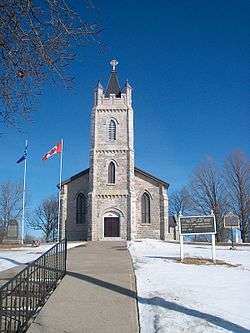Christ Church Royal Chapel
| Christ Church, Her Majesty's Chapel Royal of the Mohawk | |
|---|---|
 | |
| Location | Deseronto, Ontario, Canada |
| Founded | 1784 |
| Built | 1843 |
| Architect | John George Howard |
| Architectural style(s) | Modified Gothic |
| Governing body | Parks Canada |
| Website |
www |
Christ Church, Her Majesty's Chapel Royal of the Mohawk is located near Deseronto, Ontario. It is one of only six Royal chapels outside of the United Kingdom, and one of two in Canada (the other is Her Majesty's Royal Chapel of the Mohawks near Brantford, Ontario). It was designated as a national historical site in 1995 and is administered by the Anglican Parish of Tyendinaga, Diocese of Ontario. It was elevated to a Chapel Royal by The Queen in 2004.
History
The history of the chapel begins with the forced relocation by American revolutionaries of the Tyendinaga Mohawks from their indigenous lands in what is now upper New York State to lands provided by George III in recognition to their service to the British during the revolutionary war. They settled in the Tyendinaga Mohawk Territory on the shores of the Bay of Quinte in 1784.
The Royal chapel is in regular use as a parish church of the Anglican Diocese of Ontario. While not housed in the chapel, on special occasions, a silver Communion set given by Queen Anne in 1711 as a symbol of the alliance between the Crown and the Mohawks, is displayed and used. Also, there is a triptych in the Mohawk language and a bell given by George III, a Royal coat of arms of the United Kingdom given by George V, and a bible given by Queen Victoria.
Present day
A communion chalice was given by Elizabeth II in 1984 to mark the bicentennial of the coming of the United Empire Loyalists, including the Mohawks, to Ontario. In addition, Elizabeth II also presented a set of eight silver handbells to the Chapel Royal in 2010. The chapel also houses a memorial window given by Dr. Oronhyateka, who is buried at the Royal chapel.
Plaques commemorating the service of Mohawks during the First and Second World Wars hang in the chapel, demonstrating the continuing bond between the Tyendinaga Mohawks and the Crown.
The Chapel Royal has undergone major restoration work in recent years.
Style
Built to symbolise the political and military alliance between the British Crown and the Mohawk Peoples, and to house a number of gifts given to the Mohawks by the Royal Family over three centuries, it was built by the Mohawks themselves in a simplified Gothic Revival style in 1843. The new church replaced a wooden structure which had been built near the site when the Mohawks arrived in 1784. The style, popular in the mid 19th century, is demonstrated in the narrow lancet windows and dripstones, stepped piers on the tower and flanks of the nave, and crenellations and pinnacles on the spire, all contributing to an overall sense of verticality common to gothic architecture.
-

The tablet inscribed above the entrance to the church.
-

The interior of the church.
-

The Triptych given by King George III containing the creed, the Ten Commandments, and the 'Our Father' in the Mohawk Language.
-

The Royal Coat of Arms given by King George V to replace an earlier set which were lost in a fire. These arms hang above the west door.
-

The memorial window given by Dr. Oronhyateka.
-

The Bible given to the Mohawks by Queen Victoria.
-

This is the note written in the front of the Bible.
See also
The Canadian Crown and Aboriginal peoples
External links
- Christ Church webpage
- Parish of Tyendinaga website
- Parks Canada website - Christ Church
- Ontario Heritage Trust Christ Church Royal Chapel 1843 Constructed by its Mohawk congregation to replace an earlier log chapel, Christ Church houses part of the communion plate that had been given to the Chapel Royal at Fort Hunter, New York by Queen Anne in 1712. The bell presented to the church in 1798 by George III has since been recast.
Coordinates: 44°11′08″N 77°04′24″W / 44.18555°N 77.07341°W